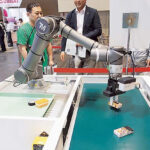ASIA ELECTRONICS INDUSTRYYOUR WINDOW TO SMART MANUFACTURING
Dobot Unlocks Potential of AI and Robotics
Dobot Robotics, the creator of the first desktop collaborative robots, has introduced the brand new Dobot X-Trainer, a groundbreaking dual-armed, teleoperated AI training platform. With the new robot training platform, customers can experience the future of robotics. Specifically, the Dobot X-Trainer, which is now available for pre-order, supports the development of AI algorithms and machine learning models.
What makes the X-Trainer stand out? Let’s delve into its core components and features.

Product Core Components
The Dobot X-Trainer integrates Teleoperated Master Hand, Dobot Nova2 (including end gripper, end camera), and a removable mounting platform (with global camera).
Product Features
Precision
With 0.05mm high-precision dual robotic arms, the Dobot X-Trainer delivers industrial-grade performance. It offers the flexibility to handle a wide range of complex operations, from precision lab tasks to real-world industrial applications.
Speed
The X-Trainer features a 25Hz high-performance motion interface. As a result, it highlights a 150% faster response time compared to similar products, ensuring swift and efficient operation.
Efficiency
Additionally, it has reduced training time by 70% and autonomously completes dishwashing or other simple tasks in just 2 hours. The integrated master-slave robotic arm, combined with a removable base platform, dramatically increases efficiency and deployment flexibility. Moreover, it is easy to deploy and use in various environments, catering to the needs of research, education, and industry.
Expandability
Dobot offers a software platform specifically designed for data training, supporting basic teleoperation and trajectory recording functions. Particularly, it generates data formats suitable for AI training. Also, it provides an open API interface for user-driven data training and research, expanding the platform’s application possibilities.
Applications
Aside from developing AI algorithms and machine learning models, Dobot’s X-Trainer suits educational research applications. Specifically, they are useful for teaching AI and robotics concepts in schools and universities and conducting experiments and research in robotics laboratories.
For household robots, they can offer automatic dishwashing and laundry folding solutions for busy households. Also, they can assist with household chores such as cleaning, organizing, and gardening, and provide companionship and entertainment through interactive features and voice assistants.
-08 April 2024-




